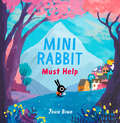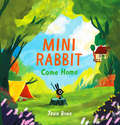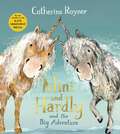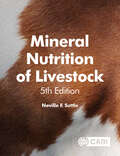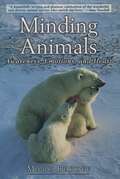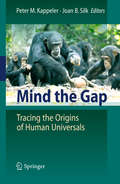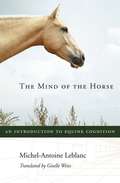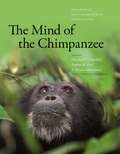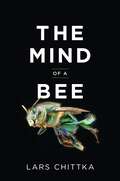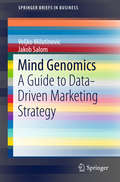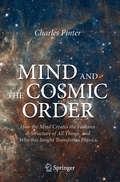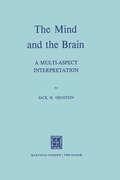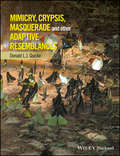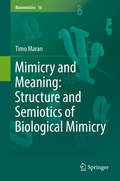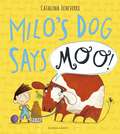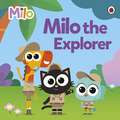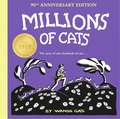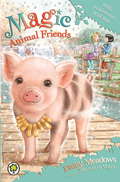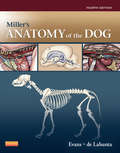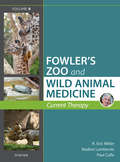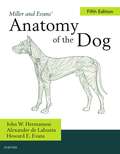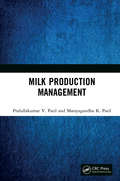- Table View
- List View
Mini Rabbit Must Help (Mini Rabbit #02)
by John BondMini Rabbit is back in another adventure from leading new talent John Bond!
Mini Rabbit Come Home (Mini Rabbit)
by John BondMini Rabbit is back in another adventure from leading new talent John Bond!
Mini and Hardly and the Big Adventure
by Catherine RaynerMini is small, and Hardly is smaller – and neither of them are happy about it in this gorgeously illustrated, heart-warming picture book about unicorns from Kate Greenaway Medal-winning Catherine Rayner.Mini and Hardly are fed up of being small. Being grown-up would be so much better! They could eat what they want, stay up all night, and go on adventures. So . . . why wait? But it’s not long before the two little unicorns find themselves on an adventure a little bigger than they'd bargained for. Perhaps being small isn't so bad – after all, it makes you perfect for the BIGGEST cuddles.
Mineral Nutrition of Livestock
by Neville SuttleThe fifth edition of this important book reviews recent advances in livestock mineral nutrition, updated throughout with new references that reflect the growing complexity of mineral metabolism. Major related themes covered include the assessment of the 'mineral value' of feeds, the false hopes placed on organic mineral supplements and limiting the 'mineral footprint' of livestock production to lower environmental pollution. Also discussed are new developments and concepts including: Salt tolerance and optimizing production in salt-rich environments. Use of phytase rather than phosphate supplements in pig and poultry rations. Demineralization of the skeleton during confinement. Recognition of sub-acute, clinical hypocalcaemia as a disorder in dairy cows. The assay of 'free' plasma B12 to assess cobalt status of cattle. Limitations of cell culture and ligated loop techniques for assessing bioavailability. Following a clear and easy to reference structure, the book also considers potential pitfalls, such as misleading estimates of mineral requirements for growth, and misinterpretation of genomic markers for mineral requirements and bioavailability of supplements. An essential resource for researchers and students in animal nutrition, agriculture and veterinary medicine, this book also forms a useful reference for veterinary practitioners and those concerned with human nutrition and environmental protection.
Minding Animals: Awareness, Emotions, and Heart
by Marc BekoffThinking bees, ice-skating buffaloes, dreaming rats, happy foxes, ecstatic elephants, despondent dolphins--in Minding Animals, Marc Bekoff takes us on an exhilarating tour of the emotional and mental world of animals, where we meet creatures who do amazing things and whose lives are filled with mysteries. Following in the footsteps of Konrad Lorenz and Niko Tinbergen, Bekoff has spent the last 30 years studying animals of every stripe--from coyotes in Wyoming to penguins in Antarctica. He draws on this vast experience, as well as on the observations of other naturalists, to offer readers fascinating stories of animal behavior, including grooming and gossip, self-medication, feeding patterns, dreaming, dominance, and mating behavior. Many of these stories are truly incredible--chimpanzees medicating themselves with herbal remedies, elephants clearly mourning a dead group member--but this is not simply a catalog of amazing animal tales, for Bekoff also sheds light on many of the more serious issues surrounding animals. He offers a thought-provoking look at animal cognition, intelligence, and consciousness and he presents vivid examples of animal passions, highlighting the deep emotional lives of our animal kin. All this serves as background for his thoughtful conclusions about humility and animal protection and animal well-being, where he urges a new paradigm of respect, grace, compassion, and love for all animals. Marc Bekoff has gone deep into the minds, hearts, spirits, and souls of animals, giving him profound insight into their lives, and no small insight into ours. Minding Animals is an important contribution to our understanding of animal consciousness, a major work that will be a must read for anyone who loves nature.
Mind the Gap: Tracing the Origins of Human Universals
by Peter M. Kappeler Joan SilkThis volume features a collection of essays by primatologists, anthropologists, biologists, and psychologists who offer some answers to the question of what makes us human, i. e. , what is the nature and width of the gap that separates us from other primates? The chapters of this volume summarize the latest research on core aspects of behavioral and cognitive traits that make humans such unusual animals. All contributors adopt an explicitly comparative approach, which is based on the premise that comparative studies of our closest biological relatives, the nonhuman primates, provide the logical foundation for identifying human univ- sals as well as evidence for evolutionary continuity in our social behavior. Each of the chapters in this volume provides comparative analyses of relevant data from primates and humans, or pairs of chapters examine the same topic from a human or primatological perspective, respectively. Together, they cover six broad topics that are relevant to identifying potential human behavioral universals. Family and social organization. Predation pressure is thought to be the main force favoring group-living in primates, but there is great diversity in the size and structure of social groups across the primate order. Research on the behavioral ecology of primates and other animals has revealed that the distribution of males and females in space and time can be explained by sex-speci?c adaptations that are sensitive to factors that limit their ?tness: access to resources for females and access to potential mates for males.
The Mind of the Horse: An Introduction To Equine Cognition
by Michel-Antoine LeblancHorses were first domesticated about 6,000 years ago on the vast Eurasian steppe, yet only in the last two decades have scientists begun to explore the mental capacities of these animals. In The Mind of the Horse, Michel-Antoine Leblanc presents an encyclopedic synthesis of scientific knowledge about equine behavior and cognition, providing experts and enthusiasts alike with an up-to-date understanding of how horses perceive, think about, and adapt to their physical and social worlds. Much of what we think we know about "the intelligence of the horse" derives from fragmentary reports and anecdotal evidence. Putting this accumulated wisdom to the test, Leblanc introduces readers to rigorous experimental investigations into how horses make sense of their world under varying conditions. He describes the anatomical and neurophysiological characteristics of the horse's brain, and compares these features with those of other species, to gain an evolutionary perspective. A horseman himself, Leblanc also considers the opinions of renowned riding masters, as well as controversies surrounding the horse's extraordinary mental powers that have stirred in equestrian and scientific circles. The Mind of the Horse brings together in one volume the current state of equine research and will likely stimulate surprising new discoveries.
The Mind of the Horse: An Introduction To Equine Cognition
by Michel-Antoine LeblancHorses were first domesticated about 6,000 years ago on the vast Eurasian steppe, yet only in the last two decades have scientists begun to explore the mental capacities of these animals. In The Mind of the Horse, Michel-Antoine Leblanc presents an encyclopedic synthesis of scientific knowledge about equine behavior and cognition, providing experts and enthusiasts alike with an up-to-date understanding of how horses perceive, think about, and adapt to their physical and social worlds. Much of what we think we know about "the intelligence of the horse" derives from fragmentary reports and anecdotal evidence. Putting this accumulated wisdom to the test, Leblanc introduces readers to rigorous experimental investigations into how horses make sense of their world under varying conditions. He describes the anatomical and neurophysiological characteristics of the horse's brain, and compares these features with those of other species, to gain an evolutionary perspective. A horseman himself, Leblanc also considers the opinions of renowned riding masters, as well as controversies surrounding the horse's extraordinary mental powers that have stirred in equestrian and scientific circles. The Mind of the Horse brings together in one volume the current state of equine research and will likely stimulate surprising new discoveries.
The Mind of the Chimpanzee: Ecological and Experimental Perspectives
by Elizabeth V. Lonsdorf Stephen R. Ross Tetsuro Matsuzawa Jane GoodallUnderstanding the chimpanzee mind is akin to opening a window onto human consciousness. Many of our complex cognitive processes have origins that can be seen in the way that chimpanzees think, learn, and behave. The Mind of the Chimpanzee brings together scores of prominent scientists from around the world to share the most recent research into what goes on inside the mind of our closest living relative. Intertwining a range of topics—including imitation, tool use, face recognition, culture, cooperation, and reconciliation—with critical commentaries on conservation and welfare, the collection aims to understand how chimpanzees learn, think, and feel, so that researchers can not only gain insight into the origins of human cognition, but also crystallize collective efforts to protect wild chimpanzee populations and ensure appropriate care in captive settings. With a breadth of material on cognition and culture from the lab and the field, The Mind of the Chimpanzee is a first-rate synthesis of contemporary studies of these fascinating mammals that will appeal to all those interested in animal minds and what we can learn from them.
The Mind of a Bee
by Lars ChittkaA rich and surprising exploration of the intelligence of bees Most of us are aware of the hive mind—the power of bees as an amazing collective. But do we know how uniquely intelligent bees are as individuals? In The Mind of a Bee, Lars Chittka draws from decades of research, including his own pioneering work, to argue that bees have remarkable cognitive abilities. He shows that they are profoundly smart, have distinct personalities, can recognize flowers and human faces, exhibit basic emotions, count, use simple tools, solve problems, and learn by observing others. They may even possess consciousness.Taking readers deep into the sensory world of bees, Chittka illustrates how bee brains are unparalleled in the animal kingdom in terms of how much sophisticated material is packed into their tiny nervous systems. He looks at their innate behaviors and the ways their evolution as foragers may have contributed to their keen spatial memory. Chittka also examines the psychological differences between bees and the ethical dilemmas that arise in conservation and laboratory settings because bees feel and think. Throughout, he touches on the fascinating history behind the study of bee behavior.Exploring an insect whose sensory experiences rival those of humans, The Mind of a Bee reveals the singular abilities of some of the world’s most incredible creatures.
Mind Genomics: A Guide to Data-Driven Marketing Strategy (SpringerBriefs in Business)
by Veljko Milutinovic Jakob SalomIn this book, the authors describe how Mind Genomics works - a revolutionary marketing method that combines the three sciences of Mathematics, Psychology, and Economics - in a masterful way. Mind Genomics helps the seller of products and services to know what people are thinking about them before one ever commits to an approach by knowing what is important to the people one is trying to influence. Mind Genomics identifies what aspects of a general topic are important to the audience, how different people in the audience will respond to different aspects of that topic, and how to pinpoint the viewpoints of different audience segments to each aspect of the topic.A careful step by step approach explains what activities ought to be taken and what scenarios must be followed while applying this method in order to find the right way to capture the hearts and minds of targeted audiences. This book explains how Mind Genomics plays a matching game with one’s potential audience and various ways one can present the products and ideas resulting in a systematic approach to influencing others, backed by real data; how one can play with ideas, see patterns imposed by the mind and create new, inductive, applied sciences of the mind, measuring the world using the mind of man as the yardstick. In details it describes how everyday thought is transferred into actionable data and results.Whether one is a senior marketer for a large corporation, a professor at a university, or administrator at a hospital, one could use Mind Genomics to learn how to transform available information into actionable steps that will increase the products sales, or increase the number of interested students for a new university program, or the number of satisfied patients in the hospital with their medical conditions kept at highest levels after leaving it. Mind Genomics was first introduced by Dr. Howard Moskowitz, an alumnus of Harvard University and the father of Horizontal Segmentation - a widely accepted business model for targeted marketing and profit maximization.
Mind and the Cosmic Order: How the Mind Creates the Features & Structure of All Things, and Why this Insight Transforms Physics
by Charles PinterThe topic of this book is the relationship between mind and the physical world. From once being an esoteric question of philosophy, this subject has become a central topic in the foundations of quantum physics. The book traces this story back to Descartes, through Kant, to the beginnings of 20th Century physics, where it becomes clear that the mind-world relationship is not a speculative question but has a direct impact on the understanding of physical phenomena. The book’s argument begins with the British empiricists who raised our awareness of the fact that we have no direct contact with physical reality, but it is the mind that constructs the form and features of objects. It is shown that modern cognitive science brings this insight a step further by suggesting that shape and structure are not internal to objects, but arise in the observer. The author goes yet further by arguing that the meaningful connectedness between things — the hierarchical organization of all we perceive — is the result of the Gestalt nature of perception and thought, and exists only as a property of mind. These insights give the first glimmerings of a new way of seeing the cosmos: not as a mineral wasteland but a place inhabited by creatures.
The Mind and the Brain: A Multi-Aspect Interpretation
by J.H. Ornstein2 no predictions or experimental findings based on the Identity Theory differ from those based on mind-brain Parallelism or Epiphenomenal ism, i.e., Dualism in general. The Identity Theory, therefore, must stand or fall on its reputed conceptual advantages over Dualism. Then the conceptual issues at stake in the mind-brain problem are discussed. The kernel of truth present in the Identity Theory is shown to be obscured by all the talk about reducing sensations to neural processes. An attempt is made to characterize pain adequately as a pattern or complex of bodily processes. This view is then reconciled with the asymmetry in the way one is aware of one's own pains and the way in which others are. This asymmetry constitutes an epistemological dualism which no philosophical theory or scientific experiment could alter. The sense in which experiences are both mental and physical is thus elucidated. A Multi-Aspect Theory of the mind is presented and defended. Five aspects of pain are discussed in some detail: experiential, neural, bodily, behavioral and verbal. Having a mind characteristically involves having all of these features except the bodily (i.e., a physical irregularity). Thus having a mind characteristically entails having experiences and a healthy, functioning brain. It also involves being able to act and speak reasonably intelligently.
Mimicry, Crypsis, Masquerade and other Adaptive Resemblances: The Ecology And Evolution Of Adaptive Resemblance
by Donald L. QuickeDeals with all aspects of adaptive resemblance Full colour Covers everything from classic examples of Batesian, Mullerian, aggressive and sexual mimicries through to human behavioural and microbial molecular deceptions Highlights areas where additonal work or specific exeprimentation could be fruitful Includes, animals, plants, micro-organisms and humans
Mimicry, Crypsis, Masquerade and other Adaptive Resemblances: The Ecology And Evolution Of Adaptive Resemblance
by Donald L. QuickeDeals with all aspects of adaptive resemblance Full colour Covers everything from classic examples of Batesian, Mullerian, aggressive and sexual mimicries through to human behavioural and microbial molecular deceptions Highlights areas where additonal work or specific exeprimentation could be fruitful Includes, animals, plants, micro-organisms and humans
Mimicry and Meaning: Structure and Semiotics of Biological Mimicry (Biosemiotics #16)
by Timo MaranThe present book analyses critically the tripartite mimicry model (consisting of the mimic, model and receiver species) and develops semiotic tools for comparative analysis. It is proposed that mimicry has a double structure where sign relations in communication are in constant interplay with ecological relations between species. Multi-constructivism and toolbox-like conceptual methods are advocated for, as these allow taking into account both the participants’ Umwelten as well as cultural meanings related to specific mimicry cases.From biosemiotic viewpoint, mimicry is a sign relation, where deceptively similar messages are perceived, interpreted and acted upon. Focusing on living subjects and their communication opens up new ways to understand mimicry. Such view helps to explain the diversity of mimicry as well as mimicry studies and treat these in a single framework. On a meta-level, a semiotic view allows critical reflection on the use of mimicry concept in modern biology. The author further discusses interpretations of mimicry in contemporary semiotics, analyses mimicry as communicative interaction, relates mimicry to iconic signs and focuses on abstract resemblances in mimicry. Theoretical discussions are illustrated with detailed excursions into practical mimicry cases in nature (brood parasitism, eyespots, myrmecomorphy, etc.). The book concludes with a conviction that mimicry should be treated in a broader semiotic-ecological context as it presumes the existence of ecological codes and other sign conventions in the ecosystem.
Milo's Dog Says MOO!
by Catalina EcheverriIt's Milo's birthday, and – guess what? He's allowed his very own dog! But the 'dog' Milo chooses is much larger than a dog should be. He also doesn't like bones, or chasing cats and – get this – he doesn't bark. Instead, he says MOO! Warmhearted and original, Milo's Dog Says MOO! is the perfect feel-good picture book. And proof that it's what's on the inside that counts.
Milo: Milo the Explorer
by MiloMilo, Lofty and Lark are transported to the jungle to become real-life explorers! Follow them past Skull Rock, through the Tunnel of Trees and across the Risky Ravine in search of valuable treasure.What will Milo and friends discover during their adventure?Want more Milo? Try:Milo: Meet Milo!Milo: Where's Milo? A Search-and-Find BookMilo: Milo and Friends Little Library
Millions of Cats
by Wanda GagWanda Gág's timeless tale follows an old man who is looking for the perfect cat. But when he finds them the cats are all too lovely to leave so he returns with 'hundreds of cats, thousands of cats, millions and billions and trillions of cats'. How will he choose which cat to keep?
Millie Picklesnout's Wild Ride: Book 19 (Magic Animal Friends #19)
by Daisy MeadowsLily and Jess can't wait for the Friendship Forest Funfair on the magical Sapphire Isle. But the lake around it has turned wild and dangerous... could this be the work of wicked witch Grizelda? Tiny piglet Millie Picklesnout must help the girls make the waters safe again for everyone!
Miller's Anatomy of the Dog - E-Book
by Howard E. Evans Alexander de LahuntaNow in full-color, Miller’s Anatomy of the Dog, 4th Edition features unparalleled coverage of canine morphology, with detailed descriptions and vivid illustrations that make intricate details easier to see and understand. Updated content reflects the latest knowledge on development, structure, and function, making this a valuable reference for anatomists, veterinary students, technicians, clinicians, experimentalists, and breeders. It is also useful in specialty fields such as mammalogy, biomechanics, and archaeology.Chapters are logically organized by body system for quick reference. Contributors are expert anatomists who provide the most current information and share their knowledge of particular structures. An introductory chapter includes breed categories from both the American and British Registry Clubs to give you a clearer understanding of dog breeds and how they are determined. NEW! Elaborate, full-color illustrations created by an expert medical illustrator bring canine structures to life and enhance your understanding of their function. New and updated content reflects the most up-to-date nomenclature from the Nomina Anatomica Veterinaria (NAV) — the standard reference for anatomical (zootomical) terminology. Text and bibliographic references from the most current literature allow you to access all primary sources of information for further study and interpretation.
Miller - Fowler's Zoo and Wild Animal Medicine Current Therapy, Volume 9 E-Book
by R. Eric Miller Nadine Lamberski Paul P. CalleBringing together a globally diverse range of timely topics related to zoo and wild animals, Fowler’s Zoo and Wild Animal Medicine, Volume 9 is an invaluable tool for any professional working directly with wildlife and zoo animals. The text’s user-friendly format guides readers through biology, anatomy, and special physiology; reproduction; restraint and handling; housing requirements; nutrition and feeding; surgery and anesthesia; diagnostics, and therapeutics for each animal. Two new co-editors and a globally diverse group of expert contributors each lend their expertise on a wide range of new topics — including a new section on emerging wildlife diseases covering topics like MERS, Equine Herpesvirus, and Ebola in great apes. Other new topics integrated into this ninth volume include: stem cell therapy in zoo medicine, cardiac disease in great apes, disease risk assessment in field studies, Tasmanian devil tumors, and the latest information on the elephant herpes virus. With all its synthesized coverage of emerging trends, treatment protocols, and diagnostic updates new to the field, Fowler’s is a reference you don’t want to be without.Current therapy format ensures that each CT volume in the series covers all new topics that are relevant at the time of publication. Synthesized topics offer the right amount of depth — often fewer than 10 pages — to maintain an accessible format. General taxon-based format covers all terrestrial vertebrate taxa plus selected topics on aquatic and invertebrate taxa. Updated information from the Zoological Information Management System (ZIMS) has been incorporated to keep readers up to date on this worldwide system.Globally diverse panel of expert contributors each incorporate the latest research and clinical management of captive and free-ranging wild animals throughout the world.NEW! Two new co-editors (for a total of three editors) each lend their expertise on a wide range of new wild and zoo animal topics. NEW! Section on emerging wildlife diseases includes chapters on MERS, SARS, Ebola in great apes, and a variety of other emerging wildlife diseases.
Miller and Evans' Anatomy of the Dog - E-Book
by John W. Hermanson Howard E. Evans Alexander de LahuntaFeaturing unparalleled full-color illustrations and detailed descriptions, Miller and Evan’s Anatomy of the Dog, 5th Edition makes it easy to master the intricate details of canine morphology. Content has been updated throughout the text to reflect the latest knowledge regarding the development, structure, and function of the canine body. Chapters in the text are logically organized by body system and written by expert anatomists who lend their extensive knowledge of particular structures. Plus, there’s a special introductory chapter on breed categories from the American Kennel Club to help you understand dog breeds and how they are determined. This new edition also features an enhanced focus on digital radiology and includes upgraded MR and CT scans throughout the text. Most notably, however, are the elaborate full-color illustrations by expert medical illustrators that bring complex anatomy to life in a way that no other vet text can. Overall, Miller and Evan’s Anatomy of the Dog is an invaluable reference for veterinary students, clinicians, technicians, breeders, and animal specialists alike.Elaborate full-color illustrations created by expert medical illustrators bring canine structures to life and enhance your understanding of their function.The most up-to-date nomenclature from the Nomina Anatomica Veterinaria (NAV) ― the standard reference for anatomical (zootomical) terminology — is reflected throughout the text’s content.Up-to-date text and bibliographic references from the most current literature offer easy access to all primary sources of information for further study and interpretation.Expert anatomist authors contribute their current knowledge of particular structures. Chapters logically organized by body system follows the course structure in most veterinary school curricula.Coverage of AKC breed categories offers a basic understanding of dog breeds and how they are determined by the American Kennel Club.NEW! Co-editor John W. Hermanson joins the team of Evans and de Lahunta to provide further expertise in the areas of anatomy and comparative anatomy. NEW! Upgraded digital radiology with a special emphasis on MR and CT scans has been incorporated throughout the text.
Milk Production Management
by Prafullakumar V. Patil Matsyagandha K. PatilMilk Production Management, as the name implies, provides the information on different aspects related to Milk Production Management. The information in this book will be of practical utility for actual feeding of animals e.g. chapters on various rations, nutrient requirement tables, feeding of pregnant/lactating animals, feeding of calves, silage making, hydroponics technique, azolla production different feeds and fodders, fodder cultivation, computation of rations for dairy animals, feeding during scarcity periods etc. In this book different topics like common disease problems of dairy animals and their prevention and control, methods of selection, different breeding systems, semen collection and artificial insemination, different biotechniques used in animal husbandry, milking methods, embryo transfer technique, judging of cows and buffaloes, milk synthesis and milk secretion, record keeping at dairy farms, reproductive aspects of dairy animals etc. are also covered.The book also covers different terms related to animal husbandry. This book is written in simple understandable language with description of those concepts which are useful for actual management of animals. Note: T&F does not sell or distribute the Hardback in India, Pakistan, Nepal, Bhutan, Bangladesh and Sri Lanka.
Milk Production Management
by Prafullakumar V. Patil Matsyagandha K. PatilMilk Production Management, as the name implies, provides the information on different aspects related to Milk Production Management. The information in this book will be of practical utility for actual feeding of animals e.g. chapters on various rations, nutrient requirement tables, feeding of pregnant/lactating animals, feeding of calves, silage making, hydroponics technique, azolla production different feeds and fodders, fodder cultivation, computation of rations for dairy animals, feeding during scarcity periods etc. In this book different topics like common disease problems of dairy animals and their prevention and control, methods of selection, different breeding systems, semen collection and artificial insemination, different biotechniques used in animal husbandry, milking methods, embryo transfer technique, judging of cows and buffaloes, milk synthesis and milk secretion, record keeping at dairy farms, reproductive aspects of dairy animals etc. are also covered.The book also covers different terms related to animal husbandry. This book is written in simple understandable language with description of those concepts which are useful for actual management of animals. Note: T&F does not sell or distribute the Hardback in India, Pakistan, Nepal, Bhutan, Bangladesh and Sri Lanka.
